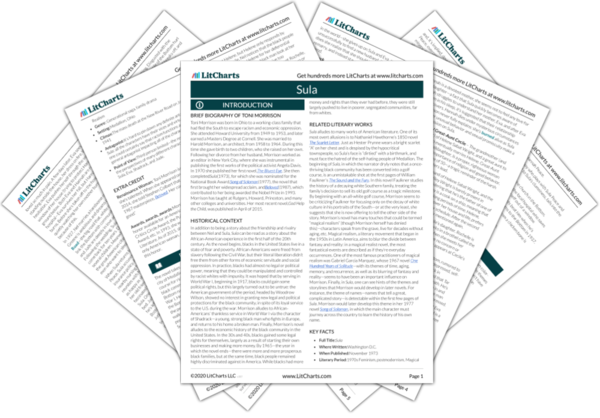Race and Racism
Like most of Toni Morrison’s novels, Sula studies the ways that black people struggle to live in America, a country with a notorious history of persecuting and oppressing black people.
Black characters in the novel face the weight of a history in which white Americans have consistently swindled blacks out of their property and their rights by manipulating laws, social norms, and even language itself. In the city of Medallion, where the novel is set…
read analysis of Race and RacismLove and Sexuality
One of the biggest challenges of reading Sula is to understand how the characters can do things that, on the surface, appear cruel, even as they claim to be acting out of love.
At times, the character’s love for one another drives them to hurt and even kill each other. There’s no better example of this than Eva Peace’s act of “loving murder.” She’s always loved her youngest child, Ralph “Plum” Peace, and nearly…
read analysis of Love and SexualitySuffering and Community Identity
In Sula, Toni Morrison examines how the people in the Bottom, most of whom are poor, have been sick, or have lost loved ones prematurely, make sense of their own tragic lives and family histories. One of the most important ways that the people of Bottom cope with tragedy is by developing an identity for themselves, and creating an identity for their community.
The townspeople’s identity as a community is founded on tragedy. There…
read analysis of Suffering and Community Identity
Women, Motherhood, and Gender Roles
Although Sula moves between many different characters’ perspectives, it is almost entirely told from the point of view of women living in the Bottom. Often, the men in the novel can’t be “pinned down” for long: their jobs keep them away from home (Wiley Wright), or their desire for independence leads them to abandon their families (Jude Greene, BoyBoy, etc.). As a result, it’s no surprise that Morrison offers many…
read analysis of Women, Motherhood, and Gender RolesSigns, Names, and Interpretation
From the first pages of Sula, it’s clear that signs and names carry a huge amount of power. The novel documents some of the ways that signs can be powerful, and how this power can be used and abused.
Morrison makes it clear that the act of naming is enormously important, and always reflects the power and personality of the “namer.” For example, throughout the novel various characters are given the opportunity to “name” one…
read analysis of Signs, Names, and Interpretation






